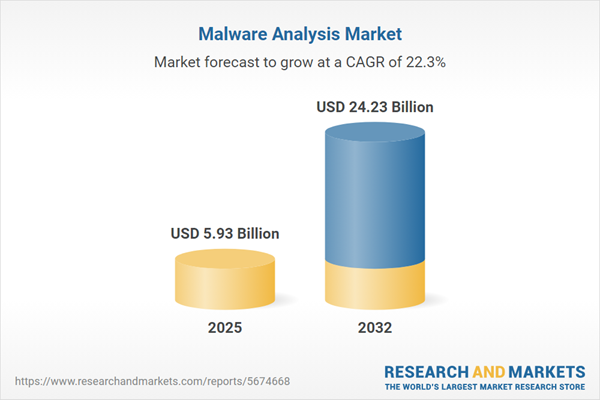Speak directly to the analyst to clarify any post sales queries you may have.
Strategic investment in the malware analysis market is increasingly critical for organizations seeking to address complex cyber threats and meet evolving regulatory requirements. Senior leaders are shifting focus toward integrated security solutions that enhance both resilience and compliance.
Market Snapshot: Malware Analysis Market Size and Growth
The malware analysis market is experiencing steady expansion, with the total market expected to rise from USD 4.83 billion in 2024 to USD 5.93 billion in 2025, reflecting a compound annual growth rate of 22.33%. This momentum is driven by increasing demand for combined threat detection capabilities, more stringent regulatory frameworks, and significant investments in digital infrastructure. Enterprises are reinforcing security programs and aligning internal processes to strengthen detection and response operations. Leadership teams are prioritizing robust frameworks that deliver oversight, support compliance, and offer flexibility to keep pace with global cybersecurity risks.
Scope & Segmentation
This report delivers actionable segmentation and technology insights, giving senior executives clear direction as they navigate a complex security environment. Decision-makers benefit from strategic recommendations tailored to the evolving needs and risk appetite of their organizations across multiple market segments.
- Malware Types: Evaluates threat categories such as adware, browser hijackers, advanced bots, rootkits, ransomware, spyware, trojans, macro viruses, boot-sector viruses, worms, and blended threats, so enterprises can adapt security postures to current attack techniques.
- Solution Types: Examines technological solutions including behavioral analytics, static inspection, sandboxing, heuristic analysis, dynamic analysis, and signature-based detection, covering the range of commercial and open-source offerings.
- Deployment Modes: Considers security program implementation across public, private, and hybrid cloud setups, alongside on-premises models. This segmentation addresses workflows for integrating solutions, supporting regulatory compliance, and enabling operational agility across organization types.
- Industry Verticals: Investigates sector-specific risks and compliance drivers for banking, insurance, defense, government, healthcare, IT, telecom, pharmaceuticals, retail, and e-commerce. Analysis reveals how different industries channel resources into security technology.
- Organization Size: Explores approaches for tailoring security programs to large enterprises and small-to-medium businesses, ensuring the scalability and appropriateness of deployed solutions.
- Regions: Reviews regional market dynamics in the Americas, Europe, Middle East and Africa, and Asia-Pacific. It details how local regulations and technology adoption rates influence enterprise security strategy.
Key Takeaways for Senior Decision-Makers
- Integration of artificial intelligence in malware analysis is streamlining investigation and incident response, improving operational efficiency for security teams.
- Choice of flexible deployment models enables organizations, particularly in highly regulated sectors, to reliably protect sensitive data while adapting to evolving compliance expectations.
- Unified security and threat intelligence platforms facilitate coordinated incident management, minimizing organizational disruption and accelerating response cycles.
- Use of behavioral and heuristic tools addresses advanced threats that frequently evade legacy detection systems, supporting more proactive defenses.
- Establishing clear forensic readiness and documentation processes simplifies audit preparation, improves compliance reporting, and reduces load on internal resources.
- Modular, automation-ready security platforms are increasingly deployed across industries to support both transformation initiatives and consistent enterprise-wide protection.
Tariff Impact: Implications of 2025 U.S. Trade Measures
Recent U.S. tariffs on cybersecurity products are prompting organizations to adjust procurement strategies, including a greater focus on domestic and open-source solutions to manage costs and ensure supply stability. Adoption of containerized and software-defined sandboxing is supporting greater agility in countering shifting risk, while tighter industry cooperation is enabling more adaptable responses to regulatory and sourcing changes in the malware analysis market.
Methodology & Data Sources
Insights in this report are drawn from in-depth market research, interviews with senior decision-makers, and third-party expert assessments. Triangulation and external review processes ensure quality and actionable value for cybersecurity planning.
Why This Report Matters
- Enables leaders to align malware analysis strategy and investments with enterprise risk objectives and fast-changing compliance requirements.
- Facilitates benchmarking with industry best practices so that technology choices are backed by evidence and operational results are improved.
- Prepares senior teams to anticipate advanced threats and coordinate cross-functional, company-wide security responses.
Conclusion
Enhancing malware analysis capabilities equips organizations to strengthen compliance and operational resilience, ensuring continued progress in preparing for new cybersecurity challenges.
Additional Product Information:
- Purchase of this report includes 1 year online access with quarterly updates.
- This report can be updated on request. Please contact our Customer Experience team using the Ask a Question widget on our website.
Table of Contents
3. Executive Summary
4. Market Overview
7. Cumulative Impact of Artificial Intelligence 2025
Companies Mentioned
The companies profiled in this Malware Analysis market report include:- Cisco Systems, Inc.
- Palo Alto Networks, Inc.
- Fortinet, Inc.
- Check Point Software Technologies Ltd.
- Trend Micro Incorporated
- Microsoft Corporation
- CrowdStrike Holdings, Inc.
- Broadcom Inc.
- FireEye, Inc.
- Sophos Group PLC
Table Information
| Report Attribute | Details |
|---|---|
| No. of Pages | 194 |
| Published | November 2025 |
| Forecast Period | 2025 - 2032 |
| Estimated Market Value ( USD | $ 5.93 Billion |
| Forecasted Market Value ( USD | $ 24.23 Billion |
| Compound Annual Growth Rate | 22.3% |
| Regions Covered | Global |
| No. of Companies Mentioned | 11 |









